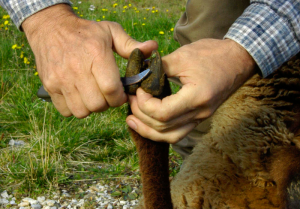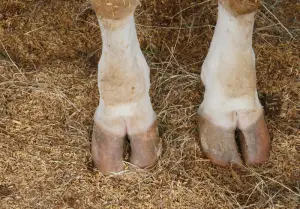Sheep Hoof Care 101
There are a number of care and maintenance concerns that must be considered when adding sheep to a homestead, but one that should be given special attention is sheep hoof care. To avoid problems of pain, lameness, and disease, it is important to take proper care of your sheep’s feet.
What is there to know about sheep hoof care? Sheep have cloven hooves made of keratin – the same protein that makes up our fingernails and hair. Sheep hooves must be trimmed regularly to both prevent lameness and as a way of inspecting the hoof for common problems that can arise.
Taking care of your sheep’s feet is a necessity in keeping a healthy, comfortable flock. Read further to learn more about the anatomy of the hoof, how and when to trim your sheep’s feet, and common hoof problems to watch out for.
Sheep Hoof Care: Anatomy Of The Sheep Hoof
Sheep have cloven hooves, meaning that the hooves are “cleaved” in half, giving them two “toes”. Hoofed animals can be classified as even-toed or odd-toed, according to the number of toes that make up the hoof. While horses are odd-toed, most other livestock are even-toed, including sheep, goats, pigs, and cattle.
Sheep hooves, like all hooves, are made up of a protein called keratin. Keratin is the same substance that makes up hair, fingernails, horns, and feathers. As is the case with our fingernails, sheep do not feel pain when their hooves are trimmed, because there are no nerve endings in the appendages. Also as with our fingernails, hooves never stop growing and must be maintained regularly.
Sheep Hoof Trimming 
While you can certainly outsource the trimming of your sheep’s feet, you don’t need to call the farrier out if you are up to the task yourself. Many homesteaders trim their sheep’s hooves themselves, particularly in the case of a small flock.
Equipment Necessary To Trim Hooves
You should have a good pair of foot paring shears and a hoof pick to trim your sheep’s feet. Both items can be found online or in your tack store for a reasonably low price.
While many kinds of shears may work, it is best to purchase a pair of shears specifically designed to trim a sheep’s or goat’s hooves. Keep them clean and keep them sharp, and they should serve you well for years. To pick out your sheep’s hooves, you can use a proper hoof pick (found in any tack store) or the tip of the shears.
How To Restrain Your Sheep For Hoof Trimming
Most sheep find hoof trimming to be a stressful experience, and will not stand still voluntarily for the process. You may use a tilt table if you have access to one, a sheep “chair”, or you can simply tip the sheep onto her rump. Most sheep tend to relax when tipped into this seated position, making them easier to handle. If you have your sheep resting on her rump (against you, a friend, or in a sheep chair), you will also have easy and quick access to her hooves.
How To Trim Sheep Hooves
When you trim your sheep’s hooves, you will first use the hoof pick, and then the shears.
- Your sheep will likely have some foreign material such as mud, manure, or rocks in the pockets of her hooves. It is important you clean this material out before moving forward so that you can get a clear view of the hoof. Pick all of this out of the pockets – many use the tip of the shears or a knife to pick the hooves, but a hoof pick will give you leverage, allowing you to make quick work of it.
- Once your sheep’s hoof is picked out, use the shears to trim away a) the excess length of the toes and b) the excess of the hoof walls. Take care to trim just a bit at a time so that you do not hit the blood supply. A faint pinkish tinge will warn you that you are getting close to this point.
When trimming, try to keep the two toes as level as possible. You may find the rear of the hooves have worn more quickly than the toes, so you may need to trim more in the front than in the back. Keeping the hooves as level as possible will help prevent lameness in your sheep.
How Often Should You Trim Sheep Hooves?
How often you need to trim your sheep’s feet will depend on a number of factors. Sheep who reside on rocky, dry ground will usually be able to go longer between trimmings than sheep grazing on soft dirt or grass.
Sheep who are pastured should be able to go longer between trimmings than sheep who are stabled. Sheep in wet environments will need more hoof care in general, including trimmings, than sheep living in drier climates. Generally, you may find yourself trimming your sheep’s hooves every 2-4 months.
When Should You Avoid Trimming Sheep Hooves?
While hoof trimming is necessary to have a healthy flock, sheep are highly sensitive to stress and care should be taken to avoid causing undue anxiety to a sheep already experiencing a stressful situation. Pregnancy, herd additions, and moves are all periods of high stress for a sheep and if it can be helped, it would be best to wait until things have settled down before trimming.
Along the same lines, you may want to time your Spring trimming with your sheep’s annual shearing so that you can limit stress by performing two necessary procedures at once.
Sheep Hooves In The Wild
Considering that hoof trimming is essential to sheep management, how is it then that wild sheep are able to thrive without trimmings? Wild sheep are not confined to pasture – they live primarily in the mountains and on rocky terrain. They walk for miles along this rocky terrain in search of food, and in doing so, keep their hooves trimmed and neat naturally. This is also true for feral pigs, feral horses, and other wild ancestors of our modern livestock.
Common Sheep Hoof Problems 
There are a number of hoof problems that can afflict a sheep’s feet, so it is important that you carefully inspect your sheep’s feet on a regular basis. Most of these diseases can be prevented through good management practices – mainly, keeping your sheep’s environment as dry and clean as possible.
Foot Scald
Foot scald is caused by the bacteria F. necrophorum, commonly found in dirt and manure. The infection is most commonly seen in humid environments or in seasons of heavy rainfall. Signs of foot scald may include white, red, or swollen tissue and/or lesions between the toes. In less severe cases of foot scald, the sheep might be successfully treated by being placed on drier footing. Further treatment may include a topical treatment of copper sulfate or a footbath containing zinc sulfate.
Foot Rot
While you may have heard the terms “foot scald” and “foot rot” used interchangeably, two different pathogens must be present to cause foot rot – both F. necrophorum and B. nodusus. While the first pathogen is found in the dirt and in manure, the latter is usually introduced to a healthy environment through the hooves of an infected animal or the bottom of another farmer’s boots.
Foot rot is the dreaded disease of the sheep industry, and the cause of many early sheep farm culls. The organisms responsible thrive in wet, warm environments, but will only survive in the dirt for up to 2 weeks. The reason it is difficult to be rid of is that sheep will continue to re-infect one another as they walk on the dirt, pasture, and bedding.
Once foot rot is introduced, it is challenging to be rid of. Therefore, prevention is a much easier management method than treatment. To prevent foot rot, keep the environment as clean and dry as possible and always quarantine new animals for a minimum of 30 days. Some breeds of sheep are more susceptible to foot rot than others. In addition, white hooves tend to be less resistant to foot rot than darker hooves.
Bluetongue
Bluetongue is spread through insects and is not contagious. It is a viral illness and can cause respiratory symptoms, fever, and general malaise. It can also cause lesions on the feet and a reddish-brown band around the coronet of the hoof, the latter of which can specifically help in diagnosis. As bluetongue is a virus, there is no specific treatment that can be given, and most healthy sheep should be able to fight the illness on their own.
Sheep Hoof Care Does Not Need To Be Overwhelming
While more care must be taken in wet and humid environments, sheep hoof care, in general, does not need to be daunting. After going through a couple of trimmings on your own, you will be able to get the process done quickly, efficiently, and with little distress. In fact, you may find that catching your sheep takes up the majority of the time it takes to complete your hoof care routine!
You can find more of my sheep care articles below!
(P.S. Save this article to your “sheep care” board on Pinterest!)

